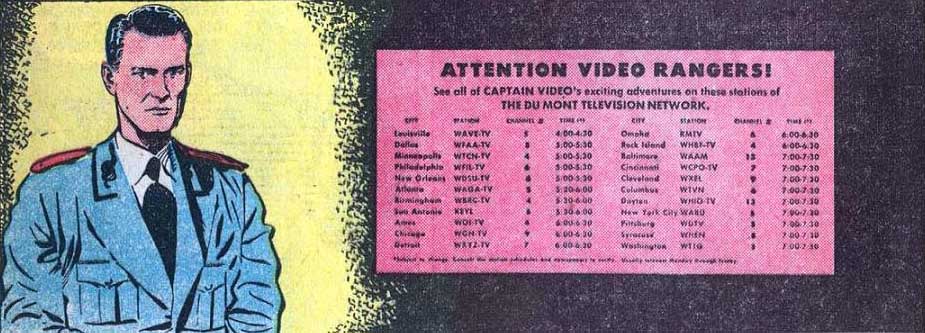CAPTAIN VIDEO IN
THE COMICS!
So, What Were Fawcett Comics?
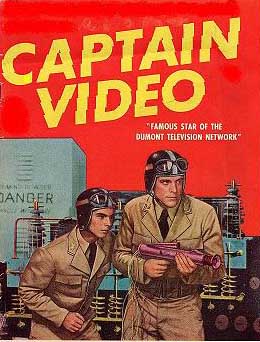 In the 1940s, the dominant comics publisher, with a number of
titles among the overwhelmingly top sellers, was Fawcett
. This publisher's superhero titles, WHIZ, CAPTAIN
MARVEL ADVENTURES CAPTAIN MARVEL JR. and MARVEL FAMILY, were as
popular in England as in the US. Most of the rest of Fawcett's lineup
consisted of second-string movie-cowboy-tiein titles, including ROCKY LANE
WESTERN, LASH LARUE
WESTERN, GABBY HAYES WESTERN, TOM MIX WESTERN, HOPALONG CASSIDY,
ROD CAMERON WESTERN, BILL BOYD WESTERN, TEX RITTER WESTERN, and MONTE HALE
WESTERN, together with anthology titles featuring the same cowboys, such
as WESTERN HEROES and SIX-GUN HEROES, all with covers displaying color
photos (or sometimes great color paintings!) of
these western action heroes whose movie adventures were always in black
and white. Among the remaining titles, most were also movie tieins, such
as NYOKA THE JUNGLE GIRL, FAWCETT MOVIE COMICS and MOTION PICTURE COMICS.
Almost all the Fawcett titles were published or re-published in England,
Australia and Canada as well.
The Fawcett
comics line was dropped about 1953 when competitor DC comics
threatened to revive lawsuits dating back to 1941, based on the charge
that Captain Marvel's adventures were often plagiarized from Superman's.
[The claim was bogus, of course, the lack of similarity between Kal-El and
the Big Red Cheese being apparent even to the youngest comics reader; but
the Fawcett brothers
were planning to get out of comics publishing anyway, and the further
threats of court action gave them a good reason.] Captain Marvel and
Hopalong Cassidy were presented to Fawcett's rival; the other western
titles were taken up by Charleton. LASH LARUE WESTERN continued into the
1960s despite the fact that Lash's actual film career ended about 1952,
and ultimately came close to 90 issues.
In the 1940s, the dominant comics publisher, with a number of
titles among the overwhelmingly top sellers, was Fawcett
. This publisher's superhero titles, WHIZ, CAPTAIN
MARVEL ADVENTURES CAPTAIN MARVEL JR. and MARVEL FAMILY, were as
popular in England as in the US. Most of the rest of Fawcett's lineup
consisted of second-string movie-cowboy-tiein titles, including ROCKY LANE
WESTERN, LASH LARUE
WESTERN, GABBY HAYES WESTERN, TOM MIX WESTERN, HOPALONG CASSIDY,
ROD CAMERON WESTERN, BILL BOYD WESTERN, TEX RITTER WESTERN, and MONTE HALE
WESTERN, together with anthology titles featuring the same cowboys, such
as WESTERN HEROES and SIX-GUN HEROES, all with covers displaying color
photos (or sometimes great color paintings!) of
these western action heroes whose movie adventures were always in black
and white. Among the remaining titles, most were also movie tieins, such
as NYOKA THE JUNGLE GIRL, FAWCETT MOVIE COMICS and MOTION PICTURE COMICS.
Almost all the Fawcett titles were published or re-published in England,
Australia and Canada as well.
The Fawcett
comics line was dropped about 1953 when competitor DC comics
threatened to revive lawsuits dating back to 1941, based on the charge
that Captain Marvel's adventures were often plagiarized from Superman's.
[The claim was bogus, of course, the lack of similarity between Kal-El and
the Big Red Cheese being apparent even to the youngest comics reader; but
the Fawcett brothers
were planning to get out of comics publishing anyway, and the further
threats of court action gave them a good reason.] Captain Marvel and
Hopalong Cassidy were presented to Fawcett's rival; the other western
titles were taken up by Charleton. LASH LARUE WESTERN continued into the
1960s despite the fact that Lash's actual film career ended about 1952,
and ultimately came close to 90 issues.
 Re-examined today the MARVEL
titles still captivate with stylish art and wild storylines, but much of
the rest of the Fawcett comics output looks like junk, with poor scripting
and inferior art. Probably the worst of the lineup is NYOKA, with the best
being LASH LARUE WESTERN, generally a winner with its slightly conflicted
dark hero, excellent art, and
complex scripts which take unpredictable twists and turns.
The Master of Space?!?
But what brings us to Fawcett here and now
is the six bi-monthly issues it published in 1951 that constituted its
only explicit TV-tie-in title, CAPTAIN VIDEO, based on the popular DuMont teleseries
(1949 - 1955). I can still recall after all these years the dreadful
disappointment that percolated through my scrawny eleven-year-old frame as
I looked at the first and then the second issues of this title... I never
picked up another. While the TV Captain
adventured in space some usually unspecified number of centuries in
the future, the comics Captain was a mere crimefighter very obviously
operating in the year 1950. While the Captain and his adversaries relied
on strange inventions and stranger weapons, the same could be said of any
superhero or super-criminal in comics of the day. For reasons known only
to Fawcett, the comic-book Captain Video was entirely earthbound (except
in one story in issue number 5, in which he briefly and for the first time
rockets to earth's moon), and there was no significant science-fictional
aspect to his adventures. The first issue of the title proclaimed Captain Video the "greatest adventure
hero of them all!", a description that put all of Fawcett's other
adventure heroes in an undeserved second rank. The final five issues
dialed the Captain's status quite far back, and he was referred to as only "the famous star of the DuMont television
network!" This was a description unlikely to be challenged, unless by
Morey Amsterdam, Jackie Gleason, or Bishop Fulton J. Sheen! Since the
title was quickly dropped from the lineup, I suspect I was far from being
the only potential reader who was put off by the mundane rut the comic ran
in.
The artwork, by George
Evans, was equally disappointing.
Re-examined today the MARVEL
titles still captivate with stylish art and wild storylines, but much of
the rest of the Fawcett comics output looks like junk, with poor scripting
and inferior art. Probably the worst of the lineup is NYOKA, with the best
being LASH LARUE WESTERN, generally a winner with its slightly conflicted
dark hero, excellent art, and
complex scripts which take unpredictable twists and turns.
The Master of Space?!?
But what brings us to Fawcett here and now
is the six bi-monthly issues it published in 1951 that constituted its
only explicit TV-tie-in title, CAPTAIN VIDEO, based on the popular DuMont teleseries
(1949 - 1955). I can still recall after all these years the dreadful
disappointment that percolated through my scrawny eleven-year-old frame as
I looked at the first and then the second issues of this title... I never
picked up another. While the TV Captain
adventured in space some usually unspecified number of centuries in
the future, the comics Captain was a mere crimefighter very obviously
operating in the year 1950. While the Captain and his adversaries relied
on strange inventions and stranger weapons, the same could be said of any
superhero or super-criminal in comics of the day. For reasons known only
to Fawcett, the comic-book Captain Video was entirely earthbound (except
in one story in issue number 5, in which he briefly and for the first time
rockets to earth's moon), and there was no significant science-fictional
aspect to his adventures. The first issue of the title proclaimed Captain Video the "greatest adventure
hero of them all!", a description that put all of Fawcett's other
adventure heroes in an undeserved second rank. The final five issues
dialed the Captain's status quite far back, and he was referred to as only "the famous star of the DuMont television
network!" This was a description unlikely to be challenged, unless by
Morey Amsterdam, Jackie Gleason, or Bishop Fulton J. Sheen! Since the
title was quickly dropped from the lineup, I suspect I was far from being
the only potential reader who was put off by the mundane rut the comic ran
in.
The artwork, by George
Evans, was equally disappointing. 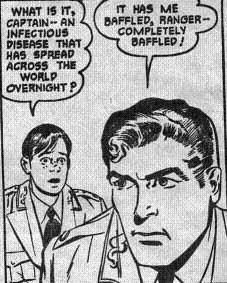 In interviews conducted many years later, Evans said
he hated the assignment, and that his ultimate souring occurred at the
beginning when he had to redraw parts of the first issue without
additional pay because the actor playing Captain Video had been replaced
after the art was finished, but before publication, and Fawcett thought
his comic version of CV looked too much like the original actor. With
respect to Evans, I think his memory must have played him false 40 to 50
years later, because Evans makes no effort to depict ANY of the TV cast.
His Captain Video is a generic Evans action hero, precisely like the ones
he had drawn a few years before for Fiction House titles such as FIGHT,
while his Video Ranger is a generic kid sidekick, complete with freckles.
It was not until issue 5 that Evans made any visible effort to get a likeness of actors Al Hodge (Captain Video) and Don Hastings (The Video Ranger). There is also
no effort to depict the "control center" of Captain Video's headquarters,
although it was a mainstay of both the TV series and the 1951 movie serial
adaptation of the series. [It is probably no coincidence that the covers
of issues 5 and 6 are also the first to use photos of the TV cast; the
previous four issues had shown anonymous models wearing uniforms and
posing with various props only vaguely suggestive of the TV uniforms and
props.]
In interviews conducted many years later, Evans said
he hated the assignment, and that his ultimate souring occurred at the
beginning when he had to redraw parts of the first issue without
additional pay because the actor playing Captain Video had been replaced
after the art was finished, but before publication, and Fawcett thought
his comic version of CV looked too much like the original actor. With
respect to Evans, I think his memory must have played him false 40 to 50
years later, because Evans makes no effort to depict ANY of the TV cast.
His Captain Video is a generic Evans action hero, precisely like the ones
he had drawn a few years before for Fiction House titles such as FIGHT,
while his Video Ranger is a generic kid sidekick, complete with freckles.
It was not until issue 5 that Evans made any visible effort to get a likeness of actors Al Hodge (Captain Video) and Don Hastings (The Video Ranger). There is also
no effort to depict the "control center" of Captain Video's headquarters,
although it was a mainstay of both the TV series and the 1951 movie serial
adaptation of the series. [It is probably no coincidence that the covers
of issues 5 and 6 are also the first to use photos of the TV cast; the
previous four issues had shown anonymous models wearing uniforms and
posing with various props only vaguely suggestive of the TV uniforms and
props.] 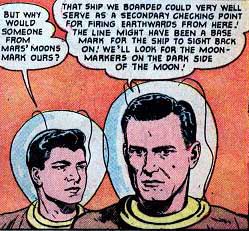 So, my guess is that Evans' memory of having to redraw
some of the first issue was based upon Fawcett's editors being unhappy for
some now-unknown reason with the appearance of his version of CV and
ordering him to redesign the character's facial features. Evans had no
trouble with continuing villain Dr. Pauli-- he drew him totally and unrecognizably differently in each
appearance. After all, the TV series had established that Pauli frequently
(well, all right, at least once!) had plastic surgery in order to baffle
his enemies, particularly Captain Video. No such explanation was given
during the run of the TV series for why the first
Captain Video looked totally different from the second, by
the way. Just as on SPACE PATROL, when one Commander Corry had to be
replaced by another, it was explained that the original leader had to "go
undercover" to break up a plot putting the entire universe at hazard... so
that a highly trained replacement would take over for the duration. But
was "Captain Video" coincidentally the name of both Video Ranger leaders,
or just a title? We never learned, alas. The two Commander Corrys were
actually supposed to be brothers, Kit and Buzz, despite their total lack
of resemblance.
Mixed Myth Messages?
A number of correspondents have told me of a
memory supposedly from watching the Captain Video TV series, in which a
huge door opens in Captain Video's Mountain
Retreat, and a rocket blasts out. These accounts baffled me because
there was never any such scene, to my knowledge, in all the six years the
series was on the air! [Nor does such a scene occur in any other 1949 - 55
Space Hero TV series known to me.] However, there are such scenes in the
Fawcett comics: in these adventures, Captain Video has a preposterous
small rocket plane, the "Whirlojet," which is about the only vehicle he
uses, and it does indeed blast out of a "launching tunnel" in the side of
the mountain Video's headquarters are perched upon.
So, my guess is that Evans' memory of having to redraw
some of the first issue was based upon Fawcett's editors being unhappy for
some now-unknown reason with the appearance of his version of CV and
ordering him to redesign the character's facial features. Evans had no
trouble with continuing villain Dr. Pauli-- he drew him totally and unrecognizably differently in each
appearance. After all, the TV series had established that Pauli frequently
(well, all right, at least once!) had plastic surgery in order to baffle
his enemies, particularly Captain Video. No such explanation was given
during the run of the TV series for why the first
Captain Video looked totally different from the second, by
the way. Just as on SPACE PATROL, when one Commander Corry had to be
replaced by another, it was explained that the original leader had to "go
undercover" to break up a plot putting the entire universe at hazard... so
that a highly trained replacement would take over for the duration. But
was "Captain Video" coincidentally the name of both Video Ranger leaders,
or just a title? We never learned, alas. The two Commander Corrys were
actually supposed to be brothers, Kit and Buzz, despite their total lack
of resemblance.
Mixed Myth Messages?
A number of correspondents have told me of a
memory supposedly from watching the Captain Video TV series, in which a
huge door opens in Captain Video's Mountain
Retreat, and a rocket blasts out. These accounts baffled me because
there was never any such scene, to my knowledge, in all the six years the
series was on the air! [Nor does such a scene occur in any other 1949 - 55
Space Hero TV series known to me.] However, there are such scenes in the
Fawcett comics: in these adventures, Captain Video has a preposterous
small rocket plane, the "Whirlojet," which is about the only vehicle he
uses, and it does indeed blast out of a "launching tunnel" in the side of
the mountain Video's headquarters are perched upon. 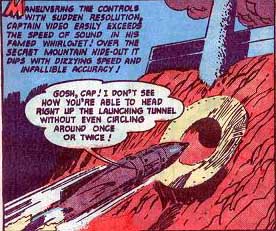 This plane was probably suggested by the
always unseen "rocket plane X-9" that Captain Video and the Ranger use to
get around during the first year of the TV series. You do have to give the
comic writer credit for worrying about how the whirlojet ever landed back
at headquarters... only a master pilot like the Captain could squirt the
ship back into the same tunnel it emerged from originally.
This plane was probably suggested by the
always unseen "rocket plane X-9" that Captain Video and the Ranger use to
get around during the first year of the TV series. You do have to give the
comic writer credit for worrying about how the whirlojet ever landed back
at headquarters... only a master pilot like the Captain could squirt the
ship back into the same tunnel it emerged from originally.
There is little or no evidence in the Fawcett comic series that the writer or artist were supplied with any reference material whatsoever, neither scripts, photos nor the like. For example, in issue 2, Captain Video uses his opticon scillometer to call the FBI... but the opticon scillometer was not a radio, much less a videophone, it was instead an electronic telescope which could see around corners and through solids! Only in the final two issues, numbers 5 and 6, do we see any evidence that Evans had some stills of TV scenes to work from. Looking back from the perspective of 50 years, the CAPTAIN VIDEO comic looks like a giant missed opportunity. But was it really? The low standard for space adventure comics was set by PLANET COMICS, filled with "good girl" art but featuring almost indescribably crappy and incoherent stories. By far the best written and best drawn science-fictional comics available in the early 1950s were the EC comics lineup of WEIRD SCIENCE and WEIRD FANTASY. But as EC's editor and publisher reminded readers in the letter column of nearly every issue of every EC title, the two science fiction titles were by far the worst sellers of the EC line, usually operating at a loss, while the best sellers, which paid for the science fiction title losses, were the horror comics, such as CRYPT OF TERROR, VAULT OF HORROR and HAUNT OF FEAR. Although there were quite a few science fictional space adventure titles available on the comics racks in 1950 - 54, it was fairly unusual for a single title to go through more than six issues. [Compare to LASH LARUE WESTERN, which clocked up nearly 50 issues at Fawcett and nearly 50 more at Charleton!] Even if CAPTAIN VIDEO's comic adventures had taken place in the 24th Century and been full of space travel, robots, rayguns, bug-eyed green aliens and pseudo-techno-razzle-dazzle in every panel, it might not have survived any longer than it did. But George Evans and at least one eleven-year-old reader would have enjoyed those six issues a lot, lot more!
